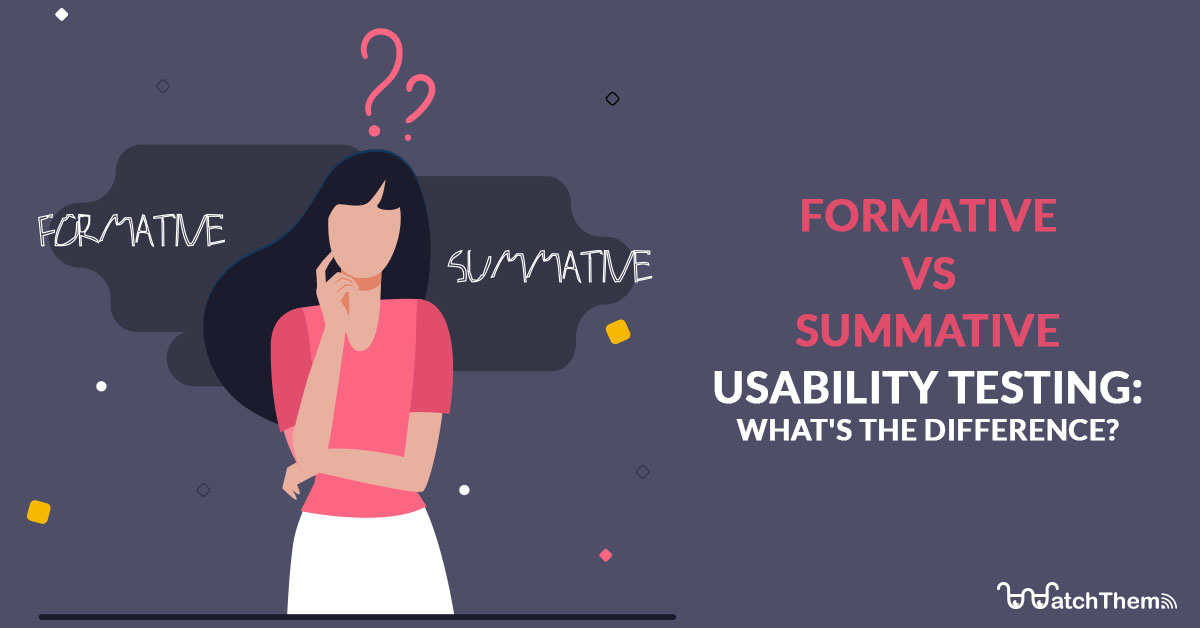Page Contents
Almost all of us have heard of usability testing at least once. We know that no matter what we’re designing, be it a website, software, or an app, to evaluate its usability, we need to conduct usability testing. However, not many people know that there are two kinds of usability testing: formative and summative usability testing.
These two types are conducted in different stages of a product redesign and for different purposes. That’s why it’s important to understand the differences between them.
Note: One way to easily conduct usability testing is using WatchThemLive’s session replay software. Keep reading to learn what it does.


What Is Formative Usability Testing?
Before we discuss the differences between formative and summative usability testing, first, we need to know the definition of each.
Formative usability testing is conducted in the early stages of designing a product and leads the designing process based on the data collected from the participants. Being qualitative in nature, it answers the questions pertaining to the hows and whys of a design’s usability.
Formative usability testing is conducted by observing participants interacting with a product iteratively to find any UI issue in the early stages of the product development process. This helps the designer understand what works and what doesn’t to shape and design the product.
When you observe participants and use the think-aloud protocol, you gain in-depth data that’ll allow you to track users’ experiences and see where they get stuck so you can create the best user interface.
What Is Summative Usability Testing?
Summative usability testing is conducted when the product is fully developed or after the product’s launch. Summative usability testing is quantitative in nature, so it gives you numeral data and answers the questions of how many and how much.
To run a summative usability test, participants are given tasks to complete, and UX metrics are measured to understand how successful the design is.
One of the easiest ways to conduct summative usability testing is using WatchThemLive’s session replay software to record participants’ screens as they interact with your website. You can capture all of their actions and collect the data you need to understand if your features are performing well. It also gives you quantitative data such as tracked events, the number of page views, time on task, etc. Watch this video to learn how it works:
Sign up now and start your path to a successful design.
Formative vs. Summative Usability Testing
Now you know that formative and summative usability testing are widely different. Let’s take a look at their differences in a broader way.
When to Conduct Formative Usability Testing?
You can conduct formative usability testing in the initial stage of designing a product. When designers are designing a new product, they run formative usability testing to understand if the elements and features of their design are working as expected or not.
When to Conduct Summative Usability Testing?
A summative usability test is done to evaluate the design after its launch in the market. You should know that formative and summative usability testing complete each other. Designers conduct summative usability tests to confirm the usability of the elements they tested through formative usability testing for a larger audience. One of the reasons that businesses tend to like summative tests more than formative tests is because it’s less expensive and time-consuming.
What Methodology Is Used to Conduct Formative Usability Testing?
The number of participants in formative usability testing is low, usually around 5 to 8 users. Participants work and interact with the product comfortably. A moderator observes their actions, listens to their thoughts, and answers their questions in a comfortable atmosphere.
What Methodology Is Used to Conduct Summative Usability Testing?
Summative usability tests are usually conducted with more than 20 participants. Designers give users tasks to complete and record their screens. In this type of test, you can’t observe participants or hear their thoughts.
Conclusion
Usability testing starts with formative tests and comes to iterative summative tests, so you need to conduct both of them for a perfect design.
In this article, we gave you the information you need to know about formative and summative usability testing and their differences.
Want to start formative and summative usability testing and don’t know where to start? Sign up to WatchThemLive and start with session replays.


